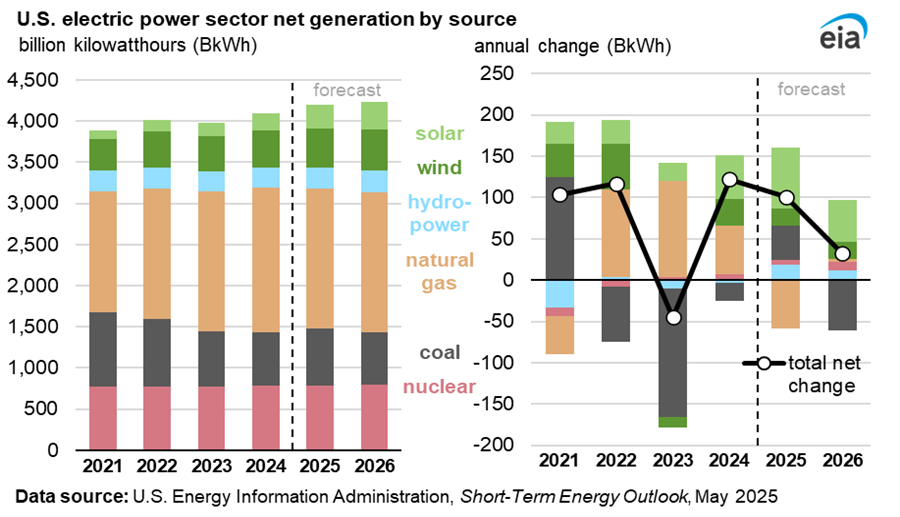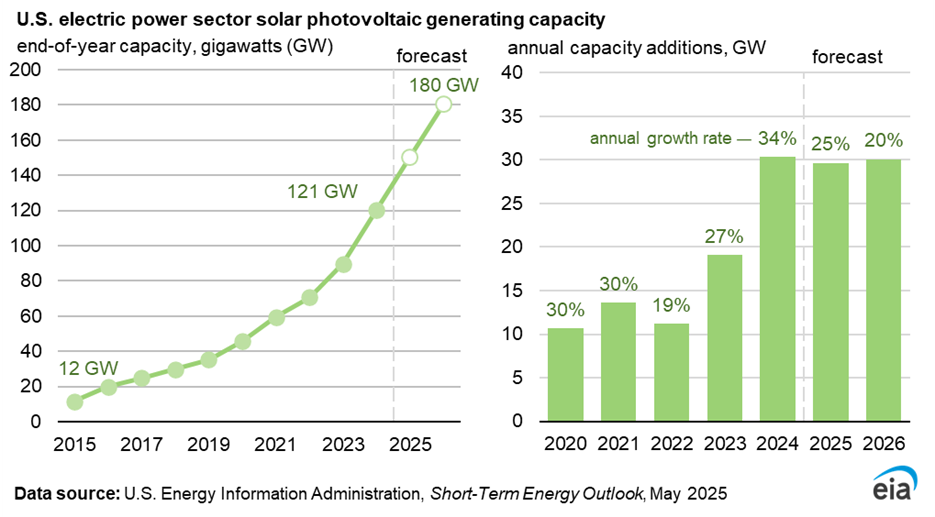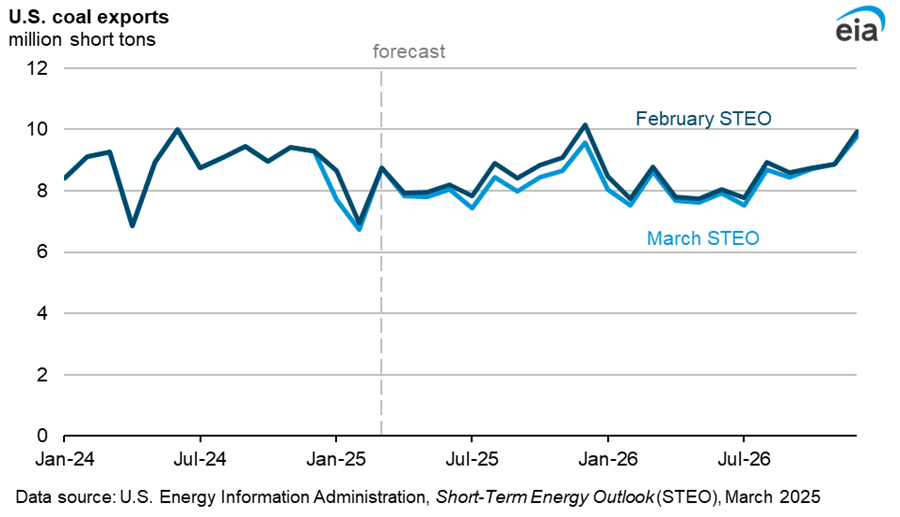Electricity, coal, and renewables
Electricity consumption
We expect 2027 to be the fourth consecutive year in which U.S. electricity sales grow after a period of little change. The commercial and industrial sectors drive sales growth in 2026 and 2027, while residential consumption mostly remains unchanged.
We forecast sales of electricity to the commercial sector will increase by 2.4% in 2026 and 4.3% in 2027 after a 2.4% increase in 2025. This increase can be largely attributed to increasing demand from large computing facilities, that include data centers. Electricity sales to the industrial sector have been relatively flat since the early 2000s but are expected to grow by 1.6% in 2026, and 3.4% in 2027 after growth of 1.7% in 2025.
Electricity sales to the commercial sector in the West South Central region, which includes Texas, increase by 10 billion kilowatthours (BkWh) in 2026 and 33 BkWh in 2027. This growth represents about 30% and 50% of total U.S. sales increase to the commercial sector in each forecast year, respectively. Electricity sales increases in the South Atlantic and East North Central regions are driving most of the rest of the commercial sector growth in the United States. Rising electricity use in these regions is partly attributed to data center growth particularly in Virginia, Georgia, and Ohio.
The West South Central is also the biggest contributor to industrial sector growth. Electricity sales to the industrial sector in the West South Central region in 2026 will account for more than 40% of the industrial sector’s total sales increase. That value increases to 70% in 2027. The industrial sector in this part of the country is consuming more electricity based on rising use for oil and natural gas extraction, petroleum refining, and LNG production.
Electricity generation
Total generation by the U.S. electric power sector in 2025 increased by 2.5%, reaching nearly 4,300 BkWh, and we expect it to rise by 1% this year and 3% in 2027, reflecting rising electricity use.
Natural gas generation declined by 4%, or 69 BkWh in 2025 mainly due to higher fuel prices last year. As natural gas prices in our forecast remain close to—or above—2025 levels, we anticipate natural gas generation will remain mostly unchanged in the forecast. Coal generation increased by 13% in 2025 due to more competitive fuel costs relative to natural gas. We expect coal generation to decline by 9% in 2026 and remain relatively flat in 2027. Although some planned coal plant retirements have been delayed, we expect U.S. coal generating capacity to decline by almost 8% (13 gigawatts) over the next two years.
Solar generation will lead total generation growth in 2026 and 2027 as more capacity is expected to come online. We anticipate solar generation to increase more than 20% each year of the forecast, after increasing by 33% in 2025.
We forecast nuclear power will generate 2% (15 BkWh) more electricity this year compared with 2025, primarily due to the Palisades Nuclear Station restart, with no change expected in nuclear generation in 2027.
Wind generation rises by 6% (28 BkWh) annually in both 2026 and 2027. This forecast accounts for the announced pause on selected offshore wind projects.
Coal markets
We expect lower demand for coal from the electric power sector to be the main driver of coal markets over the next two years. Consumption of coal by the electric power sector is the largest component of domestic coal demand. In 2025, the U.S. electric power sector consumed an estimated 418 milllion short tons (MMst) and we expect consumption to fall to by 10% this year to 376 MMst. Our 2026 forecast for coal consumption in the power sector is 4% lower than in the previous STEO, as a result of the reduction in our natural gas price forecast. We expect coal consumption in the power sector will fall an additional 1% next year to 372 MMst. The forecast decline reflects an increase in generation from renewable energy sources, particularly in the Midwest, and some scheduled coal plant retirements.
Coal stocks held by the electric power sector began 2026 at an estimated 102 MMst. We expect electric power sector stocks will grow by 15%, ending 2026 at 117 MMst and remaining at that level in 2027. Both overall U.S. coal supply (production and imports) and domestic demand from the electric power sector decline in the forecast. But supply exceeds demand in both years, leading to the increase in industry stocks.
U.S. coal production in 2025 totaled 533 MMst, up 4% from 2024. We forecast that production will decline to by 4% this year to 512 MMst and by 3% to 497 MMst in 2027. The largest drop in coal production is in the Western region. Production in the Western region declines by 6% in 2026 and by 2% in 2027, reflecting lower demand for Power River Basin coal by power generators.
U.S. exports of coal continue increasing, especially for metallurgical grades. We forecast coal exports will grow from 95 MMst last year to 99 MMst in 2026 and 101 MMst in 2027.



